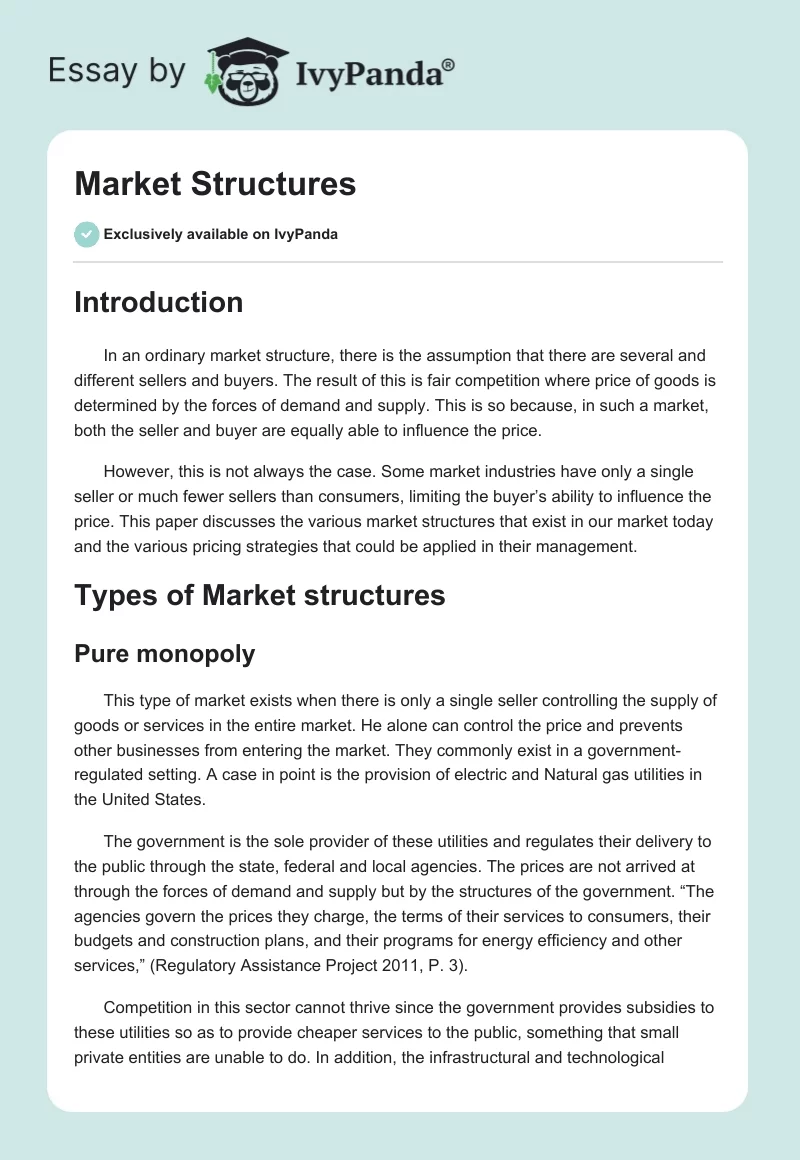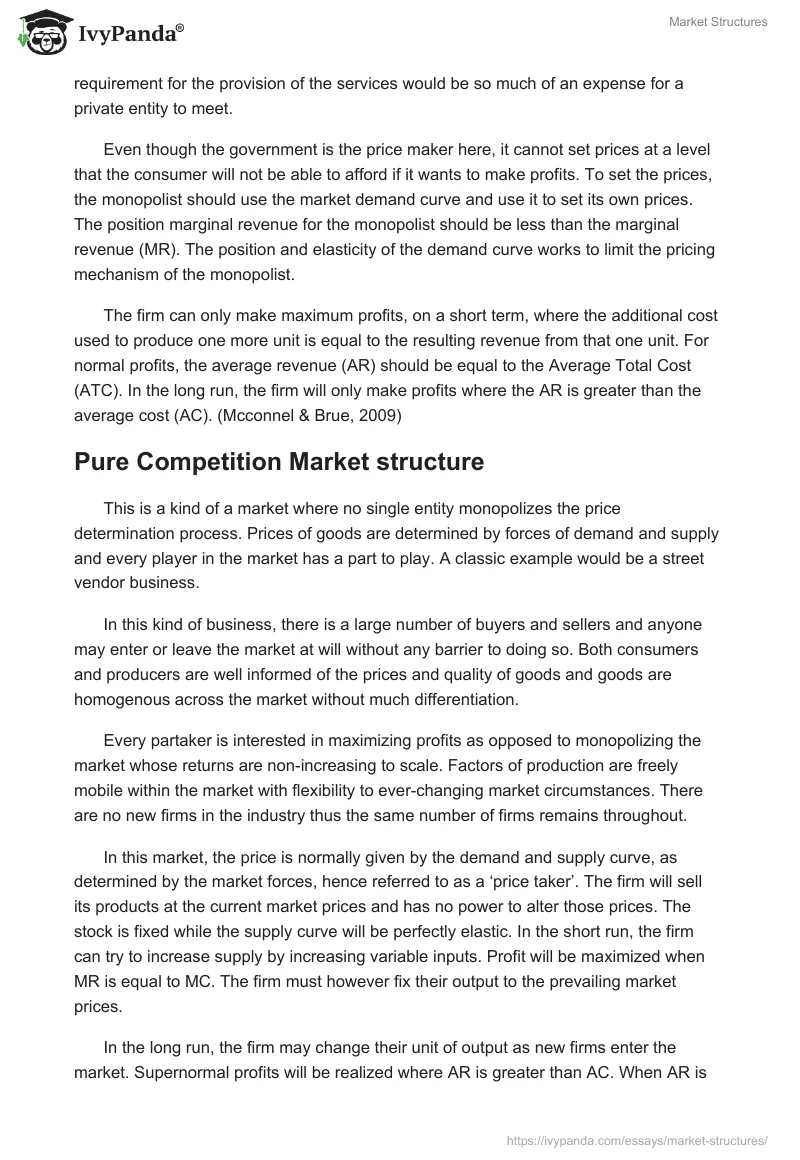Introduction
In an ordinary market structure, there is the assumption that there are several and different sellers and buyers. The result of this is fair competition where price of goods is determined by the forces of demand and supply. This is so because, in such a market, both the seller and buyer are equally able to influence the price.
However, this is not always the case. Some market industries have only a single seller or much fewer sellers than consumers, limiting the buyer’s ability to influence the price. This paper discusses the various market structures that exist in our market today and the various pricing strategies that could be applied in their management.
Types of Market structures
Pure monopoly
This type of market exists when there is only a single seller controlling the supply of goods or services in the entire market. He alone can control the price and prevents other businesses from entering the market. They commonly exist in a government-regulated setting. A case in point is the provision of electric and Natural gas utilities in the United States.
The government is the sole provider of these utilities and regulates their delivery to the public through the state, federal and local agencies. The prices are not arrived at through the forces of demand and supply but by the structures of the government. “The agencies govern the prices they charge, the terms of their services to consumers, their budgets and construction plans, and their programs for energy efficiency and other services,” (Regulatory Assistance Project 2011, P. 3).
Competition in this sector cannot thrive since the government provides subsidies to these utilities so as to provide cheaper services to the public, something that small private entities are unable to do. In addition, the infrastructural and technological requirement for the provision of the services would be so much of an expense for a private entity to meet.
Even though the government is the price maker here, it cannot set prices at a level that the consumer will not be able to afford if it wants to make profits. To set the prices, the monopolist should use the market demand curve and use it to set its own prices. The position marginal revenue for the monopolist should be less than the marginal revenue (MR). The position and elasticity of the demand curve works to limit the pricing mechanism of the monopolist.
The firm can only make maximum profits, on a short term, where the additional cost used to produce one more unit is equal to the resulting revenue from that one unit. For normal profits, the average revenue (AR) should be equal to the Average Total Cost (ATC). In the long run, the firm will only make profits where the AR is greater than the average cost (AC). (Mcconnel & Brue, 2009)
Pure Competition Market structure
This is a kind of a market where no single entity monopolizes the price determination process. Prices of goods are determined by forces of demand and supply and every player in the market has a part to play. A classic example would be a street vendor business.
In this kind of business, there is a large number of buyers and sellers and anyone may enter or leave the market at will without any barrier to doing so. Both consumers and producers are well informed of the prices and quality of goods and goods are homogenous across the market without much differentiation.
Every partaker is interested in maximizing profits as opposed to monopolizing the market whose returns are non-increasing to scale. Factors of production are freely mobile within the market with flexibility to ever-changing market circumstances. There are no new firms in the industry thus the same number of firms remains throughout.
In this market, the price is normally given by the demand and supply curve, as determined by the market forces, hence referred to as a ‘price taker’. The firm will sell its products at the current market prices and has no power to alter those prices. The stock is fixed while the supply curve will be perfectly elastic. In the short run, the firm can try to increase supply by increasing variable inputs. Profit will be maximized when MR is equal to MC. The firm must however fix their output to the prevailing market prices.
In the long run, the firm may change their unit of output as new firms enter the market. Supernormal profits will be realized where AR is greater than AC. When AR is greater than AC small firms starts quitting the market resulting into a decreased price. This will go on until AR is equal to AC and the firm makes normal profits. (McConnell & Brue, 2009)
Monopolistic Competition
This is a form of market where sellers deal with competitive products but which are differentiated from one another. It is almost like a perfect competition but though there are many firms in the industry, the products of each company are differentiated to make them unique to products of other firms.
An example is the Nike shoes. Even though many firms make shoes, which are equally competitive, only Nike makes that kind of shoe and one cannot obtain it from any other firm. The shoe is homogenous and specific to the firm and their differentiation gives monopoly over Nike to make the shoe alone.
Here, just like perfect market, the firm will take the market prices as determined by rival firms and will be forced to disregard their own influence on prices. In the short run, the firm may determine the prices depending on its level of differentiation and will have the same effects as a monopoly making huge economic prices.
However, as time goes by and competition increases, the effect of differentiation loosens gradually and the market changes to a perfect competitive one, with less profits. At the optimum quantity of production and optimum price, the firms will now earn normal profits. The equilibrium point, no new firms will be entering the industry.
Oligopoly market structure
This is a situation where there are few sellers of a commodity. The commodity being sold is however very similar but not identical to the others in the market. Products are close substitutes of each other but each firm has monopoly power over its own product. It also includes a duopoly where there are only two firms dealing with the product, e.g., Coca-cola and Pepsi. These two companies are the only known producers of carbonated soft drinks, yet their products are differentiated from each other.
For other firms to enter the market, they will require heavy investment and highly developed technology and incur high costs of promotion, thus posing a major barrier to entry of new firms and competition. The existing firms may also decide to merge, presenting even more difficulty to new entry. Both sellers have a substantial amount of influence on the pricing policies but there is mutual interdependency in price. The prices therefore remain relatively stable.
In this case, the pricing of Coca-cola will affect Pepsi’s price appreciably and the vice versa. Therefore, the best way is to agree, as between the two firms, on a pricing policy that is comfortable to the two firms. When such collusion of price determination occurs, the firms agree on an identical price, normally high, maximizing their profits and minimizing the production costs.
The pricing may be done through cost-plus pricing, which involves adding percentages of profit margin to Average Variables Cost to obtain the price. It may also be arrived at through the Mark-up pricing. Here the percentage mark-up it predetermined to cover the average margin. The AVC is estimated through the units of output produced over a given period of time. The level of output is used to determine the average cost.
Monopsony competition
Denotes a situation where one buyer buys from several existing sellers and he is therefore, the main determinant of the price in the entire market.
It is mostly found in the market for the exchange of factor services. The price he sets is lower than the market price and the quality exchanged is not correspondent to the price. For example, major sports clubs such as the National Baseball Association (NBA).
A baseball player wishing to be professional baseball player can only seek employment from NBA only. NBA will determine the minimum factor price which the player will and can take.
Though the monopsony is the price maker, if he wants to obtain quantity services, he has to part with a higher price or incur additional expenses or wages to hire more workers. The additional wages will enable him to earn more profits. These additional expenses are the marginal factor cost and the additional profits are the marginal revenue product. For maximization of profits, the firm should hire the quantity equal to the marginal factor cost and marginal revenue product, where these two curves meet, (Africa Awards, 2011).
Conclusion
The basic assumption of the existence of a perfect competitive market therefore, rarely exists. We have seen that there are markets dominated by one or two sellers or even one buyer.
Each market structure’s existence, however, is dependent on its power to influence the market price. There are also other minor types of markets that exist apart from the ones covered in this paper, for example a bilateral monopoly-duopsony, a market with two buyers and one seller. Also
Bilateral oligopoly-monopsony; one buyer and few sellers. However, all these are embedded in the five main ones discussed above.
References
Africa Awards. (2011). Market Structures: Monopsony, AmosWEB Encyclynomic WEB*pedia. Web.
McConnell, Campbell., & Brue, Stanley. (2009). Microeconomics: Principles, problems, and policies. New York: McGraw Hill. (18th Edition).
Regulatory Assistance Project. (2011). Electricity Regulation in the US: A Guide, Home Office, 50 State Street, Suite 3, Montpelier, Vermont 05602.


